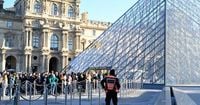In a dramatic turn of events that has sent shockwaves through the art world, the Louvre Museum in Paris has pledged to restore the imperial crown of Empress Eugénie after it was found damaged outside the museum following a daring robbery on October 19, 2025. The crown, a glittering masterpiece encrusted with more than 1,300 diamonds and 56 emeralds, was dropped by thieves as they made their escape from the world-renowned institution. The museum’s director, Laurence des Cars, has declared the crown’s restoration a symbol of "renaissance" for the Louvre, promising that it will once again shine as a testament to France’s imperial heritage (according to ABC News and the Associated Press).
The heist, which lasted less than ten minutes, saw thieves force their way through a window into the Apollo Gallery, exploiting a disabled freight elevator and a broken window to gain access. Armed with disc cutters and heavy tools, they cut through high-security display cases—without fully shattering the glass—demonstrating both precision and alarming efficiency. In total, eight precious objects were stolen, including a sapphire diadem, a necklace, and a single earring from sets linked to 19th-century Queens Marie-Amélie and Hortense. The jewel-laden crown of Empress Eugénie, however, was found near the museum, damaged but not lost (as reported by the Associated Press and France Info).
Initial examinations by the Louvre’s Department of Decorative Arts revealed that the primary damage to the crown was not caused by its fall to the ground, but rather by the rough extraction from its display case. The use of angle grinders created small openings in the security glass, allowing the thieves to remove the crown without completely destroying the case. According to Laurence des Cars, "All of the most important pieces, the diamonds and emeralds, are actually still there. A few small pieces of diamonds are missing, but that’s about it," she explained in an interview with France Info. She also noted that "one of the eight gold eagles on the crown is missing."
The crown itself, crafted by Alexandre-Gabriel Lemonnier and a centerpiece of the Second Empire, is widely recognized as an irreplaceable artifact of imperial France. While the main stones were spared, the loss of minor elements and the damage to its structure have made its restoration both a technical challenge and a symbolic act. Des Cars confirmed before the Senate’s Culture Committee that the operation would be complex but feasible, and that a scientific committee would supervise the restoration. Financial support for this endeavor has already been pledged by several patrons, ensuring that the crown will eventually return to public display (as noted by France Info and ABC News).
For the Louvre, the robbery has exposed vulnerabilities that extend far beyond a single night’s loss. The museum, which welcomes nine million visitors annually—far exceeding the four million its iconic glass pyramid was designed to accommodate—has struggled with issues ranging from outdated technical facilities to overcrowding and the unsatisfactory display of masterpieces like the Mona Lisa. The break-in has reignited fierce debate over the museum’s security protocols. Although security glass was installed in 2019, it was not engineered to withstand attacks with angle grinders, a fact that thieves exploited with devastating effect (according to the Court of Auditors report and statements from des Cars).
The incident has also brought into sharp focus the Louvre’s investment priorities. A recent report from France’s Court of Auditors, published in early November 2025, criticized the museum for favoring "visible and attractive operations"—such as acquiring new artworks and improving visitor experiences—over much-needed security upgrades. The report, which covered the period from 2018 to 2024 and was conducted before the robbery, urged the museum to accelerate its security modernization plans. The Louvre’s president, for her part, called the assessment "harsh" but acknowledged its validity, stating that she had recognized these issues upon her appointment in 2021. "I saw a tragic, brutal, violent reality for the Louvre, and as the person in charge, after all the hard work done by the teams that day—it felt right to offer my resignation," des Cars said, reflecting on her immediate response to the robbery. Her resignation, however, was refused by the culture minister.
In response to the heightened scrutiny, the Louvre has accelerated its comprehensive security overhaul. The government has requested concrete measures by November 15, 2025, and the museum is now fast-tracking its "Louvre New Renaissance" plan. Launched earlier this year, the plan is an ambitious, decade-long initiative aimed at modernizing the museum’s infrastructure, easing crowding, and improving security. With an estimated price tag of up to 800 million euros (roughly $933 million), the project also includes plans to give the Mona Lisa a dedicated gallery by 2031, addressing long-standing complaints about its current display conditions (as reported by the Associated Press and France Info).
This high-profile robbery has not only challenged the Louvre’s reputation for safeguarding some of the world’s greatest treasures but has also brought to the fore the delicate balance between accessibility, modernization, and preservation. The fact that the thieves managed to exploit a series of technical and structural weaknesses—such as a disabled freight elevator and inadequately protected display cases—has led to public outcry and political pressure for swift reform. While some have criticized the museum’s leadership for not prioritizing security, others point to the immense challenges of protecting such a vast and historic institution, especially one that must also serve as a vibrant, welcoming space for millions of visitors from around the globe.
Despite the setback, the Louvre’s commitment to restoring Empress Eugénie’s crown stands as a powerful message. "This will be a very beautiful symbol of the Louvre’s rebirth," des Cars emphasized, echoing a sentiment that resonates far beyond the museum’s walls. The restoration, under the watchful eyes of experts and patrons alike, aims not only to repair a priceless artifact but also to reaffirm the institution’s resilience and dedication to cultural heritage. As the investigation into the missing jewels continues and security reforms gather pace, the art world—and the public at large—will be watching closely to see how the Louvre transforms this crisis into an opportunity for renewal.
In the end, the fate of Empress Eugénie’s crown is more than just a story of loss and recovery; it’s a reflection of the ongoing struggle to protect history while adapting to the demands of the present. The Louvre’s renaissance, it seems, will be measured not only in restored jewels but in the museum’s ability to reinvent itself for generations to come.

